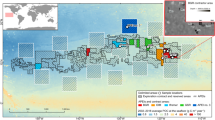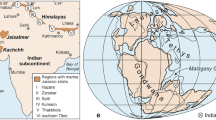Abstract
We present a high-resolution, multiproxy reconstruction of the depositional history of Lake Arreo, northern Spain, for the last 60 years. We conducted sedimentological, geochemical and diatom analyses in short cores and made a detailed comparison with regional instrumental climate data (1952–2007), limnological monitoring of the lake (1992–2008) and recent land use changes that affect the lake catchment. Chronology is based on “floating” discontinuous varve counts and 137Cs and 14C dates. Four periods were identified in the Lake Arreo recent history: (1) prior to 1963, varved facies intercalated with fine turbidite deposits, and diatom assemblages dominated by Cyclotella taxa indicate predominantly meromictic conditions, (2) from 1964 to 1978, permanent anoxia persisted in bottom waters, as shown by similar facies and diatom assemblages as before, though detrital layers were coarser, (3) from 1979 to 1994, sediment delivery to the lake increased and laminated, clastic facies were deposited, and (4) from 1995 to 2008, dominance of massive facies and an increase in Fragilaria tenera and Achnanthes minutissima reflect relatively lower lake levels, less frequent bottom anoxia with more frequent water column mixing, similar to modern conditions. The period 1952–1979 was a time of meromixis and varved facies deposition, and was characterized by higher rainfall and less intense agricultural pressure in the watershed. There were two short humid periods (1992–1993 and 1996–1998) when monitoring data show more anoxic weeks per year and relatively higher lake levels. Increased cultivation of small landholdings in 1963, and particularly after 1979, caused a large increase in sediment delivery to the lake. The inferred lake evolution is in agreement with monitoring data that suggest a transition from dominantly meromictic conditions prior to 1993–1994 to a predominantly monomictic pattern of circulation since then, particularly after 2000. The synergistic effects of intensive water extraction for irrigation and lower rainfall since 1979, and particularly since 1994, brought the long period of meromictic conditions in Lake Arreo to an end. Water balance and sediment delivery to the lake are dominant factors that control the limnological and mixing conditions in Lake Arreo and they must be considered in management and restoration plans.







Similar content being viewed by others
References
Aguilar E, Auer I, Brunet M, Peterson TC, Wieringa J (2003) Guidelines on climate metadata and homogenization. WCDMP-No. 53, WMO-TD No. 1186. World Meteorological Organization, Geneve
Alexanderson H, Moberg A (1997) Homogenization of Swedish temperature data. Part I: homogeneity for linear trends. Int J Climatol 17:25–34
Brauer A (2004) Annually laminated lake sediments and their palaeoclimatic relevance. In: Fischer H, Kumke T, Lohmann G, Flöser G, Miller G, von Storch H, Negendank JFW (eds) The climate in historical times. Towards a synthesis of Holocene proxy data and climate models. Springer, Berlin, pp 109–128
Brauer A, Casanova J (2001) Chronology and depositional processes of the laminated sediment record from Lac d’Annecy, French Alps. J Paleolimnol 25:163–177
Brunet M, Saladié O, Jones P, Sigró J, Aguilar E, Moberg A, Lister D, Walther AM, Lopez D, Almarza C (2006) The development of a new dataset of Spanish daily adjusted temperature series (SDATS) (1850–2003). Int J Climatol 26:1777–1802
Camps J, Gonzalvo I, Güell J, López P, Tejero A, Toldrà X, Vallespinos F, Vicens M (1976) El lago de Montcortès, descripción de un ciclo anual. Oecología acuática 2:99–100
Carney HJ (1987) Field tests of interspecific resource-based competition among phytoplankton (diatoms/field experiments/light/nutrients). Proc Natl Acad Sci USA 84:4148–4150
Chicote A (2004) Limnología y Ecología microbiana de un lago kárstico evaporítico: El lago de Arreo (Norte de España). Ph.D Thesis. Departamento de Ecología. Universidad Autónoma de Madrid, Madrid
Chung FH (1974a) Quantitative interpretation of X-ray diffraction patterns of mixtures: I. Matrix-flushing method for quantitative multicomponent analysis. J Appl Crystallogr 7:519–525
Chung FH (1974b) Quantitative interpretation of X-ray diffraction patterns of mixtures: II. Adiabatic principles of X-ray diffraction analysis of mixtures. J Appl Crystallogr 7:526–531
Corella JP, Moreno A, Morellón M, Rull V, Giralt S, Rico MT, Pérez A, Valero-Garcés BL (2010) Climate and human impact on a Pyrenean lake during last 6,000 years (Montcortès Lake, Spain). J Paleolimnol (this volume). doi:10.1007/s10933-010-9443-3
Diehl S, Berger S, Ptacnik R, Wild A (2002) Phytoplankton, light, and nutrients in a gradient of mixing depths: field experiments. Ecology 83:399–411
Garrote Ruíz A and Muñoz Jiménez L (2001) Mapa Geológico del País Vasco Escala 1:25.000. In: E. V. d. l. E. (EVE) (ed), Bilbao.González-Mozo ME, Chicote A, Rico E, Montes C (2000) Limnological characterization of an evaporite karstic lake in Spain (lake Arreo). Limnética 18:91–98
Hakala A (2004) Meromixis as a part of lake evolution-observations and revised classification of true meromictic lakes in Finland. Boreal Environ Res 9:37–53
Holzner CP, Aeschbach-Hertig W, Simona M, Veronesi M, Imboden DM, Kipfer R (2009) Exceptional mixing events in meromictic Lake Lugano (Switzerland/Italy), studied using environmental tracers. Limnol Oceanogr 54:112–1113
Interlandi SJ, Kilham SS (2001) Limiting resources and the regulation of diversity in phytoplankton communities. Ecology 82:1270–1282
Jones PD, Hulme M (1996) Calculating regional climatic time series for temperature and precipitation: Methods and illustrations. Int J Climatol 16:361–377
Krammer K (2002) Diatoms of Europe. Diatoms of the European inland waters and comparable habitats, Koenigstein. ARG Gantner Verlag, Koenigstein, p 584
Krammer K, Lange-Bertalot H (1986) Bacillariophyceae. Su¨sswasserflora von Mitteleuropa. Band 2. Gustav Fisher Verlag, Jena, p 876
Krammer K, Lange-Bertalot H (1988) Bacillariophyceae 3. Teil Centrales, Fragilariaceae, Eunotiaceae. Bacillariophyceae. Su¨sswasserflora von Mitteleuropa. Band 2/1. Gustav Fisher Verlag, Jena
Krammer K, Lange-Bertalot H (1991a) Bacillariophyceae 3.Teil Centrales, Fragilariaceae, Fragilariaceae, Eunotiaceae. Su¨sswasserflora von Mitteleuropa. Band 2/3. Gustav Fisher, Jena
Krammer K, Lange-Bertalot H (1991b) Bacillariophyceae 4.Teil Achnantaceae. Kritische Erga¨nzungen zu Navicula (Lineolatae) und Gomphonema. Su¨sswasserflora von Mitteleuropa. Band 2/4. Gustav Fisher, Jena
Lange-Bertalot H (2001) Diatoms of the Europe Inland waters and comparable habitats, Koenigstein, ARG Gantner Verlag KG, pp 526
Lotter AF, Sturm M, Teranes JL, Wehrli B (1997) Varve formation since 1885 and high resolution varve analyses in hypertrophic Baldeggersee (Switzerland). Aquat Sci 59:304–325
Martínez-Torres LM, González-Tapia JR, Ramón-Lluch R (1992) Batimetría y propuesta de cartografía geológica del Lago de Arreo (Diapiro de Salinas de Añana, Álava). Cuadernos de Sección. Historia 20:123–134
Martín-Puertas C, Valero-Garcés BL, Mata P, González-Sampériz P, Bao R, Moreno A, Stefanova V (2008) Arid and Humid Phases in Southern Spain during the last 4,000 years: The Zoñar Lake Record, Córdoba. Holocene 18:907–921
Martín-Puertas C, Valero-Garcés B, Mata M, Moreno A, Giralt S, Martínez-Ruiz F, Jiménez-Espejo F (2009) Geochemical processes in a Mediterranean Lake: a high-resolution study of the last 4,000 years in Zoñar Lake, southern Spain. J Paleolimnol. doi:10.1007/s10933-009-9373-0
Martín-Rubio M, Rodriguez-Lazaro J, Anadón P, Robles F, Utrilla R, Vázquez A (2005) Factors affecting the distribution of recent lacustrine ostracoda from the Caicedo de Yuso-Arreo Lake (Western Ebro Basin, Spain). Palaeogeogr Palaeoclimatol Palaeoecol 225:118–133
Meyers PA (2003) Applications of organic geochemistry to paleolimnological reconstructions: a summary of examples from the Laurentian Great Lakes. Org Geochem 34:261–289
Meyers PA, Lallier-Vergès E (1999) Lacustrine sedimentary organic matter records of late quaternary paleoclimates. J Paleolimnol 21:345
Miracle MR, Alfonso MT (1993) Rotifer vertical distributions in a meromictic basin of Lake Banyoles (Spain). Hydrobiologia 255–256:371–380
Miracle MR, Vicente E, Pedrós-Alió C (1992) Biological studies of Spanish meromictic and stratified karstic lakes. Limnetica 8:59–77
Modamio X, Peres V, Samarra F (1988) Limnology of the Montcortes Lake (1978–1979 cycle) (Limnologia del Lago de Montcortes (Ciclo 1978–1979) (Pallars Jussa, Lleida)) Oecol Aqu, vol 9
Morellón M, Valero-Garcés BL, Anselmetti F, Ariztegui D, Schnellmann M, Moreno A, Mata P, Rico M, Corella JP (2009) Late Quaternary deposition and facies model for karstic Lake Estanya (NE Spain). Sedimentology 28(25–26):2582–2599
Moreno A, Valero-Garcés B, González-Sampériz P, Rico M (2008) Flood response to rainfall variability during the last 2,000 years inferred from the Taravilla Lake record (Central Iberian Range, Spain). J Paleolimnol 40:943–961
Noren AJ, Bierman PR, Steig EJ, Lini A, Southon J (2002) Millennial-scale storminess variability in the northeast United States during the Holocene epoch. Nature 419:821–824
O’Sullivan PE (1983) Annually-laminated lake sediments and the study of quaternary environmental changes—a review. Quat Sci Rev 1:245–313
Osborn TJ, Briffa KR, Jones PD (1997) Adjusting variance for sample-size in tree-ring chronologies and other regional mean time series. Dendrochronologia 15:89–99
Peinado Lorca M, Rivas-Martínez S (1987) La vegetación de España. Servicio de Publicaciones de la Universidad de Alcalá, Alcalá de Henares, p 544
Reynolds CS (1984) Phytoplankton periodicity—the interactions of form, function and environmental variability. Freshw Biol 14:111–142
Reynolds CS (1997) Vegetation processes in the pelagic: a model for ecosystem theory. In: Kinne O (ed) Excellence in ecology 9. Ecology Institute, Oldendorf/Luhe, p 371
Reynolds CS (2006) Ecology of phytoplankton. Cambridge University Press, Cambridge, p 384
Rico E, Chicote A, González ME, Montes C (1995) Batimetría y análisis morfométrico del lago de Arreo (N. España). Limnética 1:55–58
Rodrigo MA, Miracle MR, Vicente E (2001) The meromictic Lake La cruz (central Spain) patterns of stratification. Aquat Sci 63:406–416
Romero-Viana L, Julià R, Camacho A, Vicente E, Miracle M (2008) Climate signal in varve thickness: Lake La Cruz (Spain), a case study. J Paleolimnol 40:703–714
Sáez A, Valero-Garcés BL, Giralt S, Moreno A, Bao R, Pueyo JJ, Hernández A, Casas D (2009) Glacial to Holocene climate changes in the SE Pacific. The Raraku Lake sedimentary record (Easter Island, 27°S). Quat Sci Rev 28:2743–2759
Schaller T, Wehrli B (1996) Geochemical-focusing of manganese in lake sediments—an indicator of deep-water oxygen conditions. Aquat Geochem 2:359–378
Schmidt RS, Wunsam S, Brosch U, Fott J, Lami A, Löffler H, Marchetto A, Müller HW, Pražáková M, Schwaighofer B (1998) Late and post-glacial history of meromictic Längsee (Austria), in respect to climate change and anthropogenic impact. Aquat Sci Res Across Bound 60:56–88
Schnurrenberger D, Russell J, Kelts K (2003) Classification of lacustrine sediments based on sedimentary components. J Paleolimnol 29:141–154
Sen PK (1968) Estimates of the regression coefficient based on Kendall’s tau. J Am Stat Assoc 63:1379–1389
Sturm M, Matter A (1978) Turbidites and varves in Lake Brienz (Switzerland): deposition of clastic detritus by density currents. Spec Publ Int 2:147–168
Swain EB (1984) The paucity of Blue-green Algae in Meromictic Brownie Lake: Iron-limitation of Heavy-metal Toxicity. Ph.D Thesis University of Minnesota***
Tracey B, Lee N, Card V (1996) Sediment indicators of meromixis: comparison of laminations, diatoms, and sediment chemistry in Brownie Lake, Minneapolis, USA. J Paleolimnol 15:129–132
Tyler PA, Bowling LC (1990) The wax and wane of meromixis in estuarine lakes in Tasmania. Verh Int Ver Limnol 24:117–121
Zolitschka B (2007) Varved lake sediments. In: Elias SA (ed) Encyclopedia of quaternary science. Elsevier, Amsterdam, pp 3105–3114
Acknowledgments
Financial support for this research was provided by the Spanish Inter-Ministry of Science and Technology (CICYT), through the projects LIMNOCLIBER (REN2003-09130-C02-02), IBERLIMNO (CGL2005-20236-E/CLI), LIMNOCAL (CGL2006-13327-C04-01) CLICAL (CGL2006-13327-C04-03) and GRACCIE (CSD2007-00067). The Basque Country Government provided financial support for some limnological monitoring. Additional funding was provided by the Aragonese Regional Government–Caja Inmaculada, with a travel grant to GFZ (Potsdam). Juan Pablo Corella was supported by a PhD contract paid by the CONAI + D (Aragonese Scientific Council for Research and Development). We are indebted to GFZ and IPE-CSIC laboratory staff for their collaboration in this research. We also thank the Department of Ecology, Universidad Autónoma de Madrid, for help with limnological monitoring, especially Alvaro Chicote and Carmen Fernández-Enríquez.
Author information
Authors and Affiliations
Corresponding author
Rights and permissions
About this article
Cite this article
Corella, J.P., Amrani, A.E., Sigró, J. et al. Recent evolution of Lake Arreo, northern Spain: influences of land use change and climate. J Paleolimnol 46, 469–485 (2011). https://doi.org/10.1007/s10933-010-9492-7
Received:
Accepted:
Published:
Issue Date:
DOI: https://doi.org/10.1007/s10933-010-9492-7




